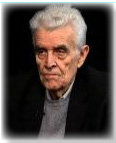



When I wrote the last chapter of my first book (Deceit, Desire and the Novel). .
. I realized I was undergoing my own version of the experience I was describing.
I was particularly attracted to the Christian elements, for example, Stephan
Verkhovensky's final journey and turn to the Gospel before his death. So I began
to read the Gospels and the rest of the Bible. And I turned into a Christian.
|
"A Conversation with Rene Girard," from The Girardian Reader, edited by James G.
Williams |
The vision of Theology & Peace is that, with God's grace, a transformation of North American Christianity is necessary
and possible. We are inspired by the insight and tools offered by Rene
Girard's groundbreaking mimetic theory in our work to uncover the wisdom of the
Gospel and the nonviolent example of Jesus' love. |
RENE GIRARD, born on Christmas day in Avignon, France in 1923, is recognized worldwide for his
discovery and development of mimetic theory. He is Professor Emeritus at Stanford University and one of only 40 members, or immortels, of the Académie Française, France's highest intellectual honor. He is the author
of numerous books and papers, including: Deceit, Desire and the Novel; Violence and the Sacred; Things Hidden Since the Foundation
of the World; The Scapegoat; and his latest, controversial Battling to the End. Mimetic theory has influenced the fields of literature, anthropology, theology, philosophy, sociology, and psychology. Discussion continues as new applications are being discovered in fields as diverse as neurology and economics. Girard's understanding of mimetic rivalry and conflict, and scapegoating, is seen by many to be the key to a completely new understanding of Christianity. A more detailed biography can be found in the Stanford Magazine article at: http://alumni.stanford.edu/get/page/magazine/article/?article_id=29620 |
